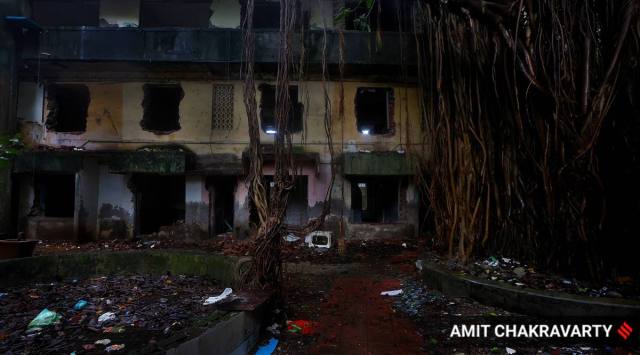What happens when a home is marked dangerous: Inside Mumbai’s dilapidated buildings
Each year before monsoon, the civic body identifies dangerous buildings unfit for human habitation and asks the residents to move out so it can demolish the unstable structure. Most tenants, who have been living in these buildings for decades under the pagdi system, choose to stay put despite the risk
 Monani Sadan, which is located a few kilometres from Mulund’s Mahadev Nivas, was put on the C1 list this year. Save for a few shops, the residents vacated the complex after the building was declared C1. (Express photo by Amit Chakravarty)
Monani Sadan, which is located a few kilometres from Mulund’s Mahadev Nivas, was put on the C1 list this year. Save for a few shops, the residents vacated the complex after the building was declared C1. (Express photo by Amit Chakravarty) An explosion in Mulund’s four-storey Mahadev Nivas on a rainy July night last year left its residents shaken. “The building’s electrical distribution board exploded due to constant water seepage through its old walls. Fortunately, nobody was injured. A few weeks before that, a huge chunk of our bedroom ceiling had collapsed,” recalled 56-year-old Rajul Thakkar, whose family had lived as tenants in the building for 50 years.
The petrified Thakkars and 30 other tenant families living in Mahadev Nivas vacated the building last year despite not having another place to call home in Mumbai. Since then, these families have been either living with relatives or in rented flats. In April, the Brihanmumbai Municipal Corporation (BMC) put Mahadev Nivas and 225 other buildings across Mumbai in the C1 category, which identifies dilapidated buildings that need to be vacated immediately and demolished.
As heavy rains lash the city, there are reports of partial or complete collapse of several buildings across Mumbai. In a bid to curb loss of life and minimise injury, BMC identifies such C1 buildings annually and releases a list before monsoon. Most reports concern the megapolis’ decrepit structures that are at least 30 years old. According to data furnished by the civic body, as of April, the city had 489 C1 buildings and the BMC had demolished 252 of them. While BMC had last year included 332 buildings in its list of C1 buildings, data released by the civic body in May states that 226 buildings were put in the C1 list. Responding to a question from The Indian Express on decline in the number of C1 buildings in the city, civic officials attributed the dip to BMC’s demolition drives, as well as shifting of structures to other categories like C2A (dangerous; requires major repair and needs to be vacated for the same).
 In April, the Brihanmumbai Municipal Corporation (BMC) put Mahadev Nivas in Mulund and 225 other buildings across Mumbai in the C1 category. Buildings falling under this category are identified as “dilapidated” and need to be vacated immediately so that they can be demolished. (Express photos by Amit Chakravarty)
In April, the Brihanmumbai Municipal Corporation (BMC) put Mahadev Nivas in Mulund and 225 other buildings across Mumbai in the C1 category. Buildings falling under this category are identified as “dilapidated” and need to be vacated immediately so that they can be demolished. (Express photos by Amit Chakravarty)
However, lack of affordable housing in Mumbai and provisions offering timely relief to residents means that many continue to live in these dilapidated structures. In many cases, tenants approach courts objecting to BMC classifying their buildings as C1.
In its March 20 judgement citing a 2018 document titled “Guidelines issued by the MCGM for declaring private and municipal buildings as ‘C1’ category (Dangerous, Unsafe)”, the Bombay High Court held the BMC cannot impose that consent must be obtained by the landlord from 100 per cent of the occupants and that consent of 51-70 per cent of the tenants for the landlord was sufficient.
 The tenants of Mahadev Nivas in Mulund vacated the building after the BMC put it in the C1 category earlier this year. Seen at the new flat rented by the Shah family near Mahadev Nivas are (from left) Heerji Shivji Shah and his daughter-in-law Heena Shah, who lived in the dilapidated building for three decades; Nand Kumar Yadav, who vacated a shop started by his grandfather in the building in 1967 about six months ago; and Rajul Thakkar, who lived with her family in the building for 50 years. (Express photo by Amit Chakravarty)
The tenants of Mahadev Nivas in Mulund vacated the building after the BMC put it in the C1 category earlier this year. Seen at the new flat rented by the Shah family near Mahadev Nivas are (from left) Heerji Shivji Shah and his daughter-in-law Heena Shah, who lived in the dilapidated building for three decades; Nand Kumar Yadav, who vacated a shop started by his grandfather in the building in 1967 about six months ago; and Rajul Thakkar, who lived with her family in the building for 50 years. (Express photo by Amit Chakravarty)
Of categories and BMC norms
While buildings in C1 category are dilapidated beyond repair, civic officials said those labelled as C2 fall under two subcategories: C2A and C2B, which means the building requires structural repairs. The last category, C3, means the building requires minor repairs.
Data on Mumbai’s 226 C1 buildings, procured by The Indian Express, shows that most buildings were located in the corporation’s P/North ward (Malad), which comprises 24 buildings; followed by T ward (Mulund), with 23 buildings; and H-West (Bandra, Khar) and K-West (Andheri West, Juhu, Versova) wards, with 22 buildings each. The least number of C1 buildings are based in C (Kalbadevi, Bhuleshwar) and E (Byculla) wards, with only two dilapidated buildings each. Speaking to The Indian Express, Kiran Dighavkar, the Assistant Municipal Commissioner of P/North ward, said, “Section 353 B of the Mumbai Municipal Corporation (MMC) Act authorises a ward officer to issue a notice on structural audit to a building under their jurisdiction that is 30 years old. Besides this, if upon visual inspection, the ward staff feels the building is dangerous, the landlord can be instructed to carry out a structural audit.”
After a structure is declared as C1, BMC issues a demolition notice to the building. Dighavkar said, “We give residents 15 days to vacate the building. In cases of no objections during this time frame, BMC shuts electricity and water supply for eight days. After eight days, BMC, with help from police, is free to vacate and demolish the building. If tenants raise objections against the C1 label, they are given time to carry out another structural audit, conducted by BMC’s empanelled structural auditors. If there is a difference in the two audit reports, another audit is carried out by the Technical Advisory committee (TAC).”
An independent committee headed by the deputy chief engineer of the building proposal department and comprising the ward’s executive engineer and other officials as its members, TAC assesses both reports and carries out a physical inspection of the building. On the basis of its evaluation, it ascertains the final category for the property concerned.



According to BMC, as of April, nine cases were pending before the TAC and 110 cases before courts. Citing examples of P/North ward’s Vasanti Bhuvan and Nathanlal Estate, where The Indian Express observed several commercial establishments operating despite its C1 label, Dighavkar said, “We declared them C1 this year. However, shops are still running there because they objected and got another audit. That audit categorised the structure as C2. The matter is pending before the TAC.”
According to civic officials and architects, most buildings that make it to the C1 list are non-cessed buildings. Cessed buildings comprises old structures that pay tax to the Maharashtra Housing and Area Development Authority (MHADA) for maintenance, whereas non-cessed buildings are privately owned buildings that do not pay this cess. Most non-cessed buildings are owned by landlords and occupied by tenants, who have been living there for generations under the Pagdi system, which means they pay a capped rent between Rs 100 and Rs 500 per month to this day.
A civic official explained, “Under the (pagdi) system, a landlord gets very little rent from tenants but has to splurge on repairs. Therefore, most landlords tend to be pro-developers. Tenants, on the other hand, have other concerns because they know there are no rules to help them if they are removed from the building.”
 Prabhudas Building, a C1 structure in Vile Parle, has been barricaded. (Express photo by Amit Chakravarty)
Prabhudas Building, a C1 structure in Vile Parle, has been barricaded. (Express photo by Amit Chakravarty)
A catch-22 situation
Just like Thakar, Heena Shah vacated Mahadev Nivas last year after living there for three decades. The condition of the structure is so bad, said Shah, that the stairs in the tumbledown building shiver even if one tiptoes on them.
“During monsoon, we would not turn on fans due to water seepage through holes in the ceiling and the high risk of short circuit. To contain seepage, we put a tarpaulin sheet over the roof,” she recounted, standing under a gaping hole in the roof at Mahadev Nivas.
“Whenever we wanted to carry out repairs, the landlord would object. He never even allowed us to drill a hole in the walls, let alone carry out repairs. That’s why the condition of the building deteriorated. The landlord wanted this to happen and for us to leave the building,” Thakkar alleged.
Since she left Mahadev Nivas, Thakkar’s family of five has been living with relatives. “How long can we stay with them?” she wondered.
 According to civic officials and architects, most buildings that make it to the C1 list are non-cessed buildings. (Express Photo by Amit Chakravarty)
According to civic officials and architects, most buildings that make it to the C1 list are non-cessed buildings. (Express Photo by Amit Chakravarty)
Mihir Kotecha, BJP MLA from Mulund, told The India Express, “There is a scheme in place in such situations by the Slum Rehabilitation Authority (SRA) for slum dwellers but there are no rules for authorised non-cessed buildings. When BMC issues a notice asking people to vacate a building, middle-class families living there for nearly 50 years are suddenly rendered homeless.”
In many cases, he claimed, landlords stop communicating with tenants after buildings are vacated. “In case non-cessed buildings are vacated, there are no regulations on landlords paying tenants a transit rent or a concrete timeline on when the structure will be reconstructed. After years of wait, landlords usually pay a nominal amount to buy out the tenants, who usually give in since most have low-paying jobs. For example, landlords will pay about Rs 20 lakh for a 200 square feet flat in Mulund, though its market value is nearly Rs 65 lakh,” alleged Kotecha.
Nand Kumar Yadav (36), who ran a medical shop inside Mahadev Nivas, said he has been left bereft of a means of livelihood for the past six months since he vacated his shop. His grandfather ran a milk shop on the premises since 1967, but 36-year-old Yadav converted it into a pharmacy in 2012. “Whenever I write to the landlord asking for updates, his representative tells me he is in his home town. He has disappeared. I don’t know what lies ahead for us. Families like ours are nothing but a question mark for the system. Even slum dwellers are given a roof by the government in such cases,” Yadav said.
Unlike him, 42-year-old Vijay Sharma’s salon, a business he inherited from his father, is still running inside Mahadev Nivas. “I have been using a rechargeable battery for light and potable water since BMC cut the water and electricity around May. I have not been able to find another affordable rental space. It’s scary operating out of this building, but there is no other way for me to sustain my family,” he said.
 Former tenants of Mahadev Nivas in Mulund alleged that though the condition of the building was terrible, the landlord prohibited them from carrying out any repair works. (Express photos by Amit Chakravarty)
Former tenants of Mahadev Nivas in Mulund alleged that though the condition of the building was terrible, the landlord prohibited them from carrying out any repair works. (Express photos by Amit Chakravarty)
A few kilometres from Mahadev Nivas lies Monani Sadan, which also made it to the C1 list this year. Barring a few shops and a lively banyan tree in the heart of the complex, Monani Sadan is a picture of desertion. A poster on one of its battered walls, put up by BMC, screams “Savdhan! Savdhan! (beware)” in big letters. After the building was declared C1, its residents claimed they vacated the building, albeit begrudgingly, but refused to take the legal route.
“The builder tore down the walls to ensure we did not return. I wanted to go to court, but my family and the others, most of whom are old, did not want to get involved in a long legal battle,” said a former resident.
Unlike these residents, the tenants of Gajanan Building No 9 in Goregaon West went to court against BMC declaring their structure unfit. A former tenant said, “Our case is pending in Bombay High Court since 2019. Around 20 families are still staying there. We believe the building only requires some repairs.”
Vadilal Gada, a resident of Prabhudas Building, a C1 structure in Vile Parle, alleged the builder “destroyed” his home on the very day the Bombay HC issued a stay order against the developer. Gada claimed, “The HC issued a stay against the builder. That evening, when we returned home from court, some bouncers prevented us from entering the building. When we finally managed to enter the building the next day, I discovered that my belongings had been damaged.”
A coterie in cahoots?
With Mumbai’s skyrocketing real estate prices, civic officials said, owners of most non-cessed buildings are approached by builders with offers of additional Floor Space Index (FSI), etc., on redevelopment of their properties. Tenants of C1 buildings and elected representatives have alleged that builders seeking to redevelop these structures are hands-in-glove with the civic administration which, at their behest, marks these structures as dilapidated.
Sandeep Patel, a former corporator from P/South ward, said, “There is a nexus between BMC and developers. The administration works at the behest of these developers.”
He added, “While it is very important to demolish inhabitable buildings to prevent loss of life, why are buildings that can be repaired brought under this category? Why can’t builders speak to tenants and decide on redevelopment with their consensus? There are countless cases like these in Mumbai and countless are now homeless.”
Legislator Kotecha said, “We have raised this issue in the state Assembly. It is necessary to have a reform policy under which the redevelopment process is hastened and the occupants are not left homeless endlessly. We are working on a policy in line with C1 category cessed buildings, which is already in place.”
However, some public representatives and architects argued that a mere policy would not suffice. “What is really required is an Act that enforces the rules and provides relief to the residents,” they said.












